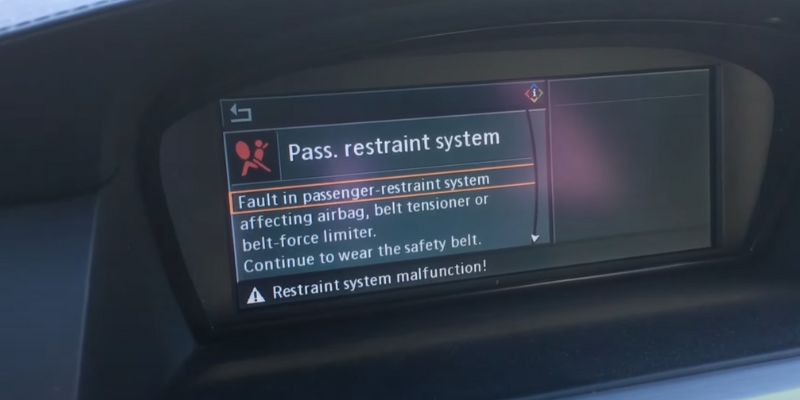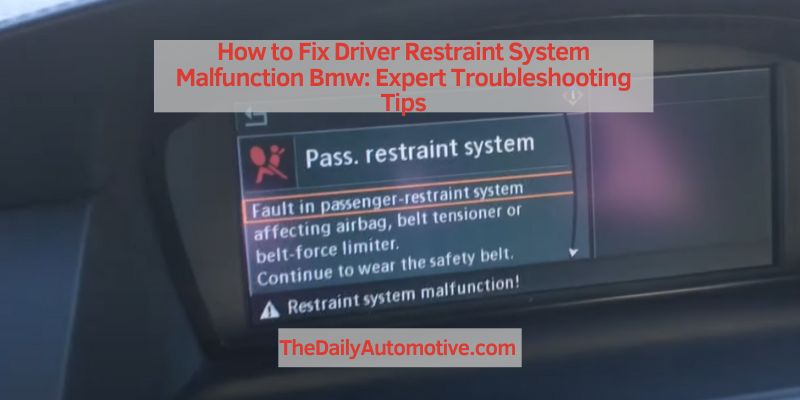How to Fix Driver Restraint System Malfunction Bmw: Expert Troubleshooting Tips
To fix the driver restraint system malfunction in your BMW, first, check if the seatbelt is properly fastened and not twisted. If the issue persists, have the system inspected by a professional mechanic for any faulty sensors or wiring.
The driver restraint system in your BMW is a crucial safety feature that ensures proper functioning in the event of a collision. When the system malfunctions, it can compromise your safety and that of your passengers. It’s essential to address any issues promptly to maintain the integrity of the system.
We’ll discuss common causes of driver restraint system malfunctions in BMW vehicles and explore steps you can take to resolve the issue swiftly and effectively. By following these guidelines, you can ensure the continued safety and reliability of your BMW’s restraint system.
Identifying Driver Restraint System Malfunction
Identifying Driver Restraint System Malfunction is crucial for maintaining the safety of your BMW. The driver restraint system, which includes the airbag and seatbelt pretensioners, plays a vital role in protecting you in the event of a collision. Recognizing the signs of a malfunctioning restraint system allows for prompt action to address the issue and ensure the ongoing safety of the vehicle’s occupants.
Common Signs Of Driver Restraint System Malfunction
Below are the common signs indicating a malfunction in the driver restraint system of your BMW. If you notice any of these signs, it is important to address the issue promptly to ensure the continued safety of the vehicle’s occupant.
- Illuminated Airbag Warning Light
- Beeping Sound When Car Starts
- Diagnostic Trouble Codes (DTCs)
Diagnostic Trouble Codes (DTCs) are another indication of a potential driver restraint system malfunction. When the vehicle’s onboard computer detects an issue with the restraint system, it may generate specific DTCs that can be retrieved using a diagnostic scan tool. These codes provide valuable information for diagnosing and addressing the underlying problem, allowing for targeted repairs to be carried out efficiently.

Troubleshooting Driver Restraint System Malfunction
When your BMW’s driver restraint system malfunctions, it’s essential to address the issue promptly to ensure the safety of the vehicle’s occupants. Troubleshooting the driver restraint system involves performing a thorough inspection and utilizing diagnostic tools to identify and resolve the underlying problem. By following the recommended troubleshooting steps, you can effectively diagnose and fix driver restraint system malfunctions in your BMW.
Performing A Visual Inspection
Start by visually inspecting the driver restraint system components for any visible damage or defects. Check the condition of the airbag, seat belt, and associated wiring for signs of wear, tear, or physical damage. If any discrepancies are found, they should be addressed immediately to ensure the proper functioning of the restraint system.
Checking For Loose Connections
Inspect the connections related to the driver restraint system, including the airbag and seat belt connectors. Ensure that all connections are secure and free from corrosion or debris that may hinder proper contact. Tighten any loose connections to restore the integrity of the system.
Evaluating The Condition Of Airbag Sensors
Assess the condition of the airbag sensors to identify any potential issues that could affect their functionality. Look for signs of physical damage or sensor misalignment, and address any discrepancies to ensure the proper operation of the airbag sensors.
Utilizing Diagnostic Tools
Utilize diagnostic tools, such as an OBD-II scanner, to retrieve diagnostic trouble codes (DTCs) associated with the driver restraint system. These codes provide valuable insight into the specific issues affecting the system and aid in the diagnostic process.
Retrieving Dtcs Using Obd-ii Scanner
Connect the OBD-II scanner to the vehicle’s diagnostic port and retrieve the DTCs related to the driver restraint system. The scanner will provide detailed error codes that pinpoint the areas of concern, allowing for a more targeted approach to troubleshooting.
Interpreting Dtcs To Isolate The Issue
Once the DTCs are retrieved, interpret them to isolate the specific fault within the driver restraint system. Each code corresponds to a particular issue, enabling you to focus on resolving the identified problem effectively.
Fixing Driver Restraint System Malfunction
When it comes to addressing a driver restraint system malfunction in your BMW, it’s crucial to take immediate action to ensure the safety of the vehicle’s occupants. Here are some essential steps you can take to fix the driver restraint system malfunction and restore the safety features of your BMW.
Addressing Loose Connections
If your BMW’s driver restraint system is malfunctioning, the first thing to check for is any loose connections. Loose connections can disrupt the proper functioning of the system, so carefully inspect and secure all the connections to ensure a snug fit.
Securing Wiring Harnesses And Connectors
Next, secure the wiring harnesses and connectors within the driver restraint system. Make sure that the wiring harnesses are properly fastened and that the connectors are firmly in place to prevent any potential disruptions in the system’s operation.
Replacing Damaged Wiring
If you find any damaged wiring during your inspection, it’s crucial to replace it immediately. Faulty or damaged wiring can compromise the effectiveness of the driver restraint system, so be thorough in identifying and replacing any compromised wiring components.
Resolving Sensor Issues
Sensor issues can often be a cause of driver restraint system malfunctions. Check for any sensor malfunctions and address them promptly. It’s important to ensure that all sensors are functioning properly to maintain the integrity of the system.
Cleaning And Calibrating Airbag Sensors
Regular maintenance of the airbag sensors is essential for preventing driver restraint system malfunctions. Clean and calibrate the airbag sensors to ensure their accuracy and responsiveness. This will help maintain the effectiveness of the driver restraint system in the event of a collision.
Replacing Faulty Sensors
If any of the sensors are found to be faulty during your inspection, it’s crucial to replace them with high-quality, compatible replacements. Faulty sensors can compromise the overall functionality of the driver restraint system, so swift replacement is essential.

Testing And Verifying Repairs
After identifying and repairing the driver restraint system malfunction in your BMW, it’s crucial to conduct thorough testing and verification to ensure that the issue has been effectively resolved. Testing and verifying repairs not only validate the efficacy of the undertaken measures but also ensure the safety and functionality of your vehicle.
Conducting System Functionality Tests
Conducting system functionality tests is essential to guarantee that all components of the driver restraint system are functioning as intended. This involves:
- Testing the deployment of the airbags through a controlled simulation
- Verifying the functionality of seat belt pre-tensioners
- Ensuring that all sensors and modules are communicating and responding appropriately
Using Vehicle-specific Diagnostic Procedures
Utilizing vehicle-specific diagnostic procedures is crucial in accurately assessing the driver restraint system. This involves:
- Employing diagnostic tools and software designed specifically for BMW vehicles
- Accessing and interpreting system-specific error codes and data
- Conducting in-depth diagnostic scans to pinpoint any underlying issues that may not be immediately evident
Verifying The Elimination Of Dtcs
Verifying the elimination of Diagnostic Trouble Codes (DTCs) is an integral part of the testing and verification process. This includes:
- Resetting the system and ensuring that previous DTCs related to the driver restraint system no longer appear
- Performing a comprehensive road test to confirm that no new DTCs are generated during normal driving conditions
- Validating the successful elimination of DTCs through further diagnostic scans and system checks
Proactive Maintenance To Prevent Recurrence
Addressing a driver restraint system malfunction in your BMW is crucial for the safety of you and your passengers. To ensure the longevity and reliability of your vehicle’s restraint system, it’s imperative to undertake proactive maintenance measures. By adhering to a regular inspection and maintenance schedule, checking the system during routine service, and implementing best practices for long-term system health, you can prevent the recurrence of driver restraint system malfunctions.
Regular Inspection And Maintenance Schedule
Implementing a regular inspection and maintenance schedule is essential to preemptively address any potential issues with the driver restraint system. Scheduling periodic inspections will help identify any wear and tear or early signs of malfunction, allowing for timely intervention and preventing more serious problems from arising.
Checking The Driver Restraint System During Routine Service
Incorporating checks of the driver restraint system as part of your routine service appointments will ensure that the system is consistently monitored for any anomalies. This proactive approach will enable immediate attention to any identified issues, reducing the risk of system malfunction.
Best Practices For Long-term System Health
Adhering to best practices for long-term system health involves strict adherence to manufacturer-recommended maintenance intervals and following all safety recall notifications. By prioritizing the OEM guidelines, you can proactively safeguard the driver restraint system from potential malfunctions.
Equally important is the implementation of regular safety system checks where components like airbags, seatbelt tensioners, and related sensors are inspected to ensure optimal functionality. This diligent approach contributes to the long-term health and reliability of the driver restraint system.
Protecting Wiring And Connectors From Environmental Damage
Safeguarding the wiring and connectors of the driver restraint system from environmental damage is crucial. Installing protective coverings and ensuring proper insulation will shield the vital components from moisture, corrosion, and other environmental hazards, thereby extending the system’s longevity.
Frequently Asked Questions For How To Fix Driver Restraint System Malfunction Bmw
How Do I Know If My Bmw Has A Driver Restraint System Malfunction?
The warning light on the dashboard or diagnostic trouble codes can indicate a malfunction. It’s crucial to have the issue diagnosed and repaired promptly by a qualified technician.
What Are The Potential Causes Of A Driver Restraint System Malfunction In My Bmw?
Common causes include sensor malfunctions, wiring issues, or problems with the airbag control module. Any of these issues can trigger a warning light or error code.
Can I Drive My Bmw If The Driver Restraint System Malfunctions?
It’s strongly advised not to drive your BMW in the event of a restraint system malfunction. Immediately have the vehicle inspected and repaired by a professional technician to ensure your safety.
Conclusion
Addressing a driver restraint system malfunction in your BMW is crucial for your safety. By following these steps, you can diagnose and fix the issue, ensuring that your vehicle’s safety features are in optimal condition. Regular maintenance and prompt attention to warning signs will keep you safe on the road.









2 Comments